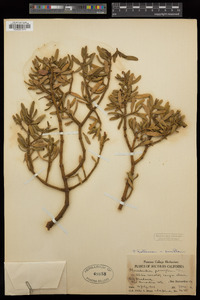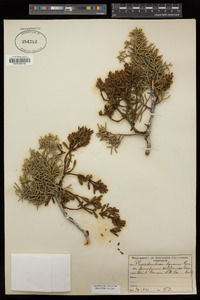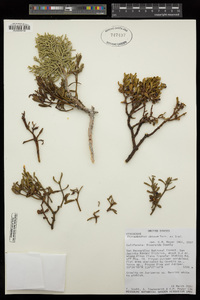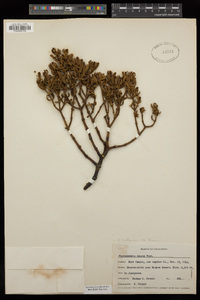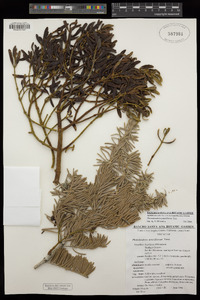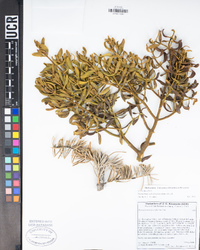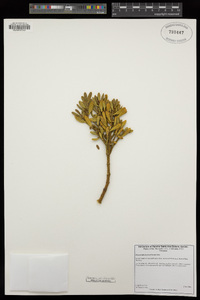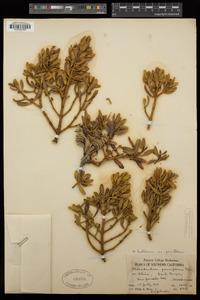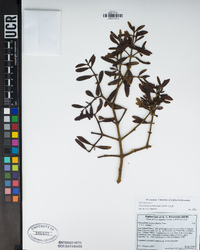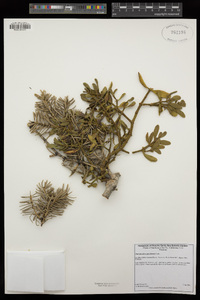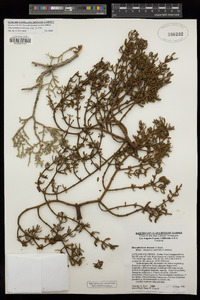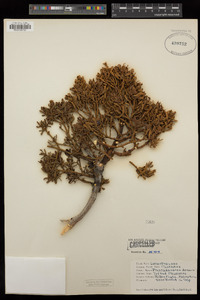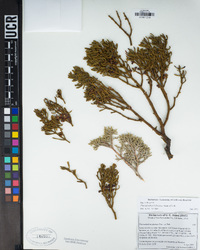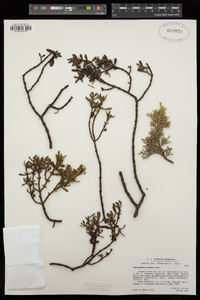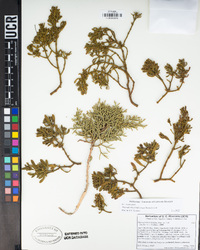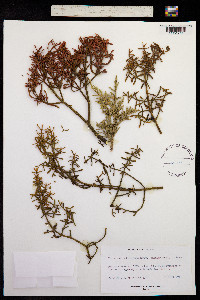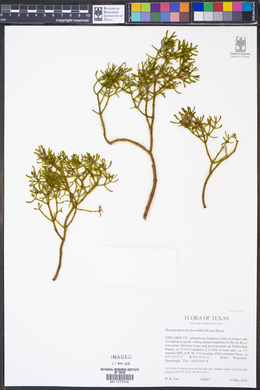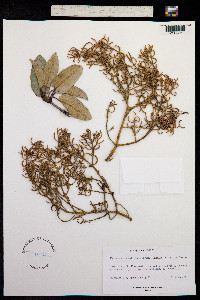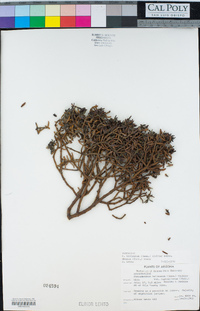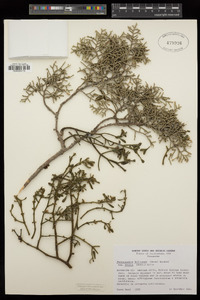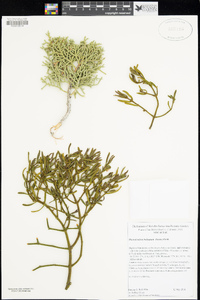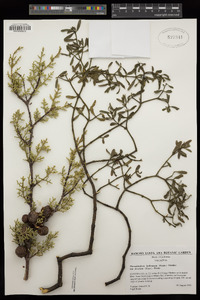Phoradendron bolleanum
|
|
|
|
Family: Santalaceae
Bollean mistletoe, more...Rough Mistletoe, dense mistletoe, fir mistletoe, phoradendron, Phoradendron densum (es: toji)
[Phoradendron bolleanum subsp. bolleanum (Seem.) Eichler, morePhoradendron bolleanum subsp. densum (Torr. ex Trel.) Wiens, Phoradendron bolleanum subsp. pauciflorum (Torr.) Wiens, Phoradendron bolleanum var. densum (Torr. ex Trel.) Fosberg, Phoradendron bolleanum var. pauciflorum (Torr.) Fosberg, Phoradendron densum Torr. ex Trel., Phoradendron guadalupense Trel., Phoradendron pauciflorum Torr., Viscum bolleanum Seem.] |
FRUIT: white-pinkish, glabrous, 4 mm in diameter. SHOOTS: 3-5 dm high, green, glabrous, the internodes 8-15 mm long. LEAVES: oblanceolate to oblong, sessile, 1.5-2.5 cm long, 2-3 mm wide, glabrous. INFLORESCENCE: staminate spikes with usually 1 fertile segment, with 6-10 flowers per segment; pistillate spikes with usually 1 fertile segment, with 2 flowers per segment. FLOWERS: glabrous. HOST: Cupressus arizonica. NOTES: Arizona cypress forests: local in c AZ: Coconino, Gila, Maricopa, Yavapai cos.; 1050-1600 m (3500-5300 ft); Jun-Aug; CA, s OR; Baja C., Mex, REFERENCES: Hawksworth, Frank G. 1994. Viscaceae. J. Ariz. - Nev. Acad. Sci. Volume 27(2), 241-245. Kearney and Peebles 1969, McDougall 1873 Duration: Perennial Nativity: Native Lifeform: Subshrub General: Perennial, aerial parasitic subshrub, much-branched, herbage greenish-yellow to brown. Leaves: Mostly less than 10 mm wide, linear-spatulate to oblong, not more than 10 mm wide, sessile or subsessile. Flowers: Two per node, borne on pistillate spikes not more than 5 mm long, spikes 1-2 jointed, calyx of both male and females flowers 3-lobed, staminate ones 6-12 flowered, pistillate ones with 2 flowers at each node, anthers 2-celled. Fruits: White or straw-colored globose berries. Ecology: Found on Abies concolor, Juniperus, and Cupressus from 3,500-7,000 ft (1067-2134 m). Notes: The keys to this species are the pistillate flowers 2 per node, the leaves linear-spatulate to oblong, less than 10 mm wide, sessile or subsessile, and the spikes of the flower not more than 5 mm long. Ethnobotany: Uncertain, but other species in the genera have uses. Etymology: Phoradendron is from Greek phor, a thief and dendron, tree-hence tree thief because of its parasitism, while bolleanum is of uncertain origin. Synonyms: None Editor: SBuckley, 2010, LCrumbacher 2011 Hawksworth 1993 Duration: Perennial Nativity: Native Lifeform: Shrub General: Aerial parasitic shrub with shoots 30-60 cm long, glabrous, green with internodes 1-2 cm long. Leaves: Oblanceolate, 1.5-3 cm long, 5-10 mm wide, glabrous. Flowers: Inflorescence with staminate spikes bearing 1-2 fertile segments with 8-12 flowers; pistillate spikes with 1 fertile segment and 2 flowers; flowers usually glabrous. Fruits: Berrylike, white-pinkish, glabrous and about 4 mm in diameter. Ecology: Found on Abies concolor in mixed conifer forests from 7,000-8,500 ft (2134-2591 m); flowers July-August. Notes: Note the inclusion of the former P. bolleanum into this species name, this expanded circumscription has expanded its range. Ethnobotany: Unknown, but other species in the genera have uses. Etymology: Phoradendron is from Greek phor, a thief and dendron, tree-hence tree thief because of its parasitism, while pauciflorum means few flowered. Synonyms: Phoradendron bolleanum subsp. pauciflorum, P. bolleanum var. pauciflorum Editor: SBuckley, 2010 Hawksworth and Wiens 1993, Kearney and Peebles 1969 Duration: Perennial Nativity: Native Lifeform: Shrub General: Perennial, aerial parasitic subshrub with shoots 30-50 cm long, green, glabrous, with internodes 8-15 mm long. Leaves: Oblanceolate to oblong, sessile, 1.5-2.5 cm long, 2-3 mm wide, glabrous. Flowers: Staminate spikes with usually 1 fertile segment; usually with 6-10 flowers per segment; pistillate spikes with usually 1 fertile segment and 2 flowers per segment; flowers are glabrous, white-pinkish, sunken along axis and 4 mm in diameter; perianth segments usually three, persistent in fruit; pistillate flower with a single style and rounded stigma. Fruits: Mucilaginous berry, 3-6 mm in diameter, sessile, explosively dehiscent. Ecology: Found on Cupressus arizonicus from 3,500-5,500 ft (1067-1676 m); flowers June-August. Notes: Distinguished by its glabrous leaves and being found on Cupressus arizonicus. Ethnobotany: Unknown, but other species in the genera have a variety of uses. Etymology: Phoradendron is from Greek phor, a thief and dendron, tree-hence tree thief because of its parasitism, while densum means dense, referring to its dense habit. Synonyms: Phoradendron bolleanum subsp. densum, P. bolleanum var. densum Editor: SBuckley, 2010 |



